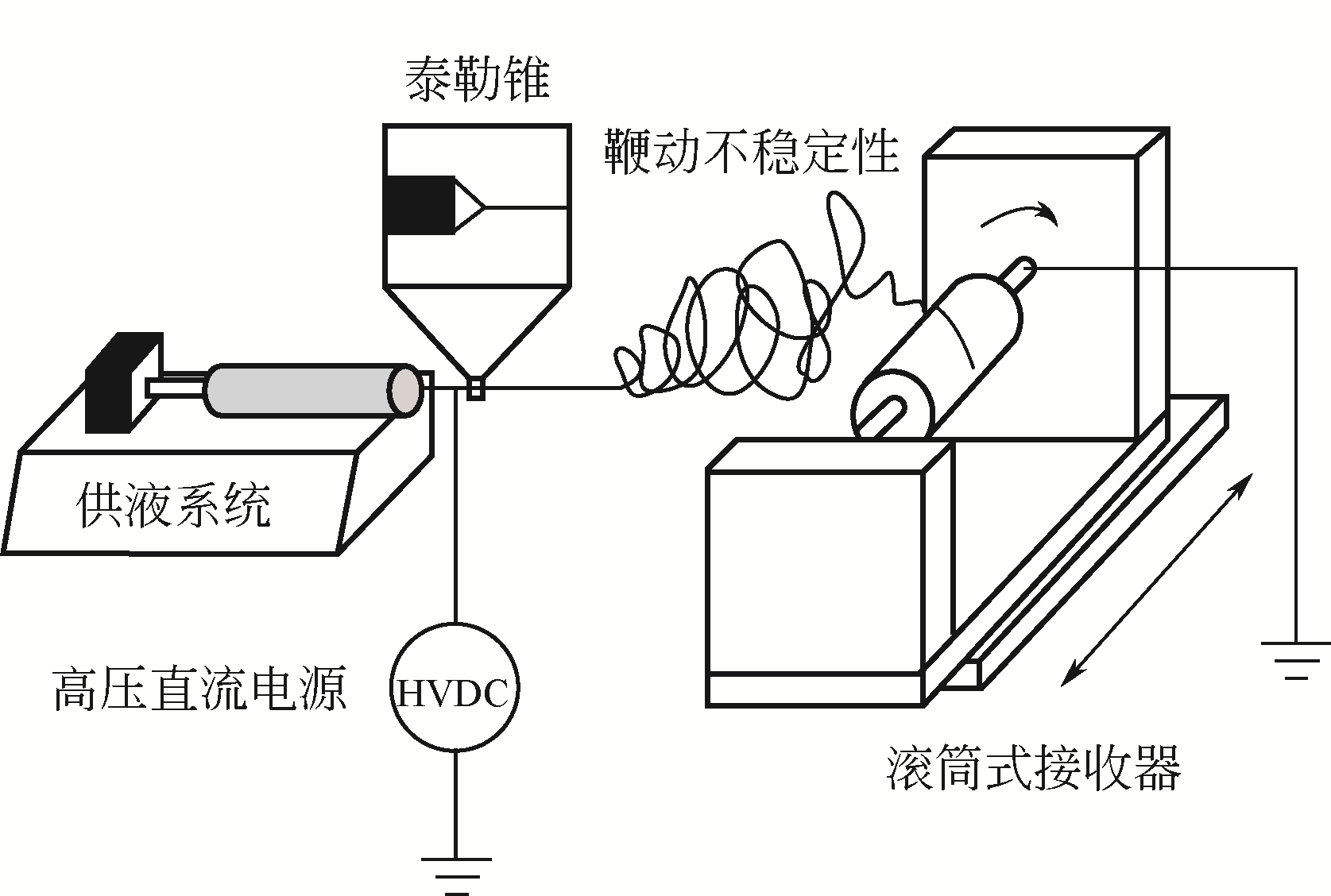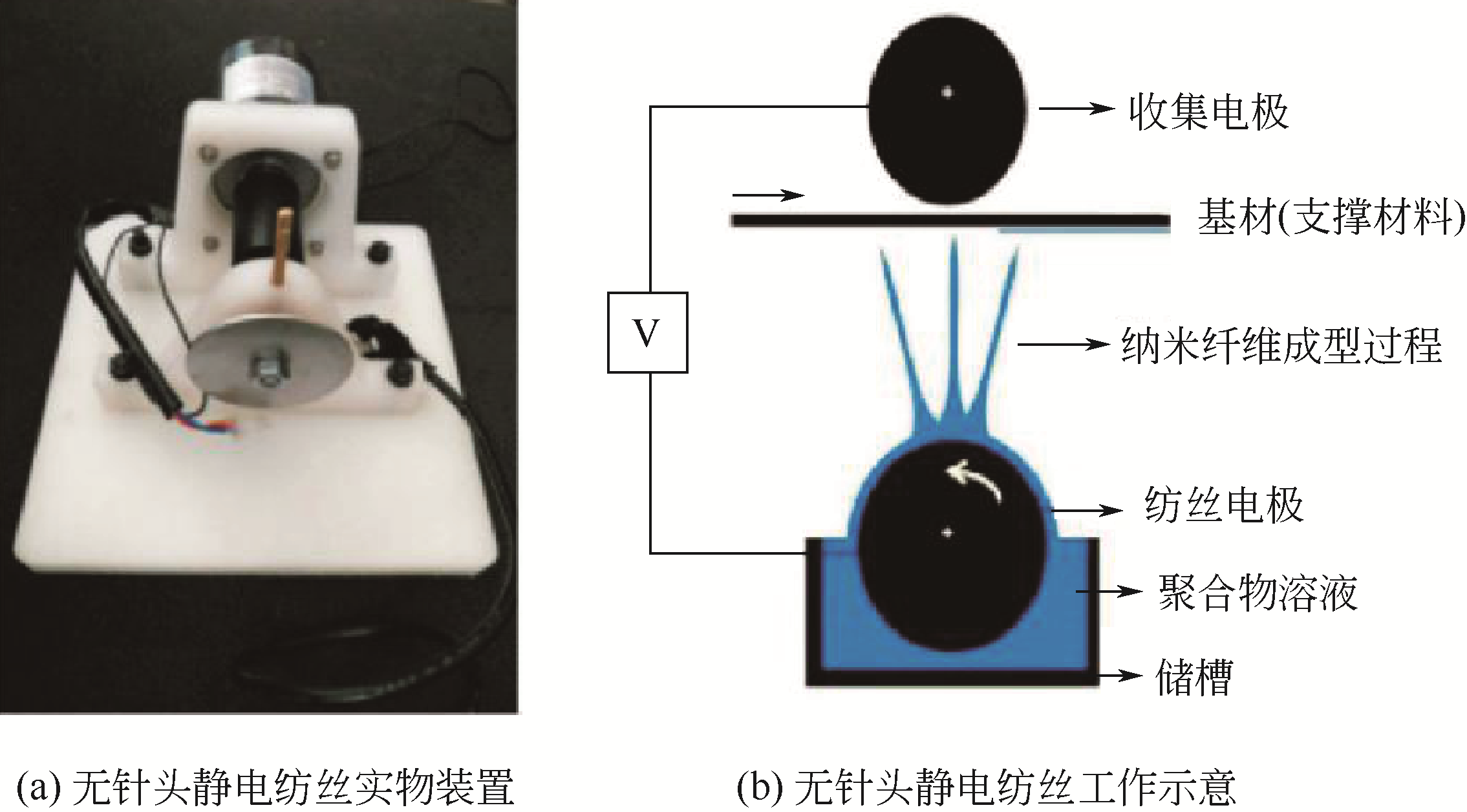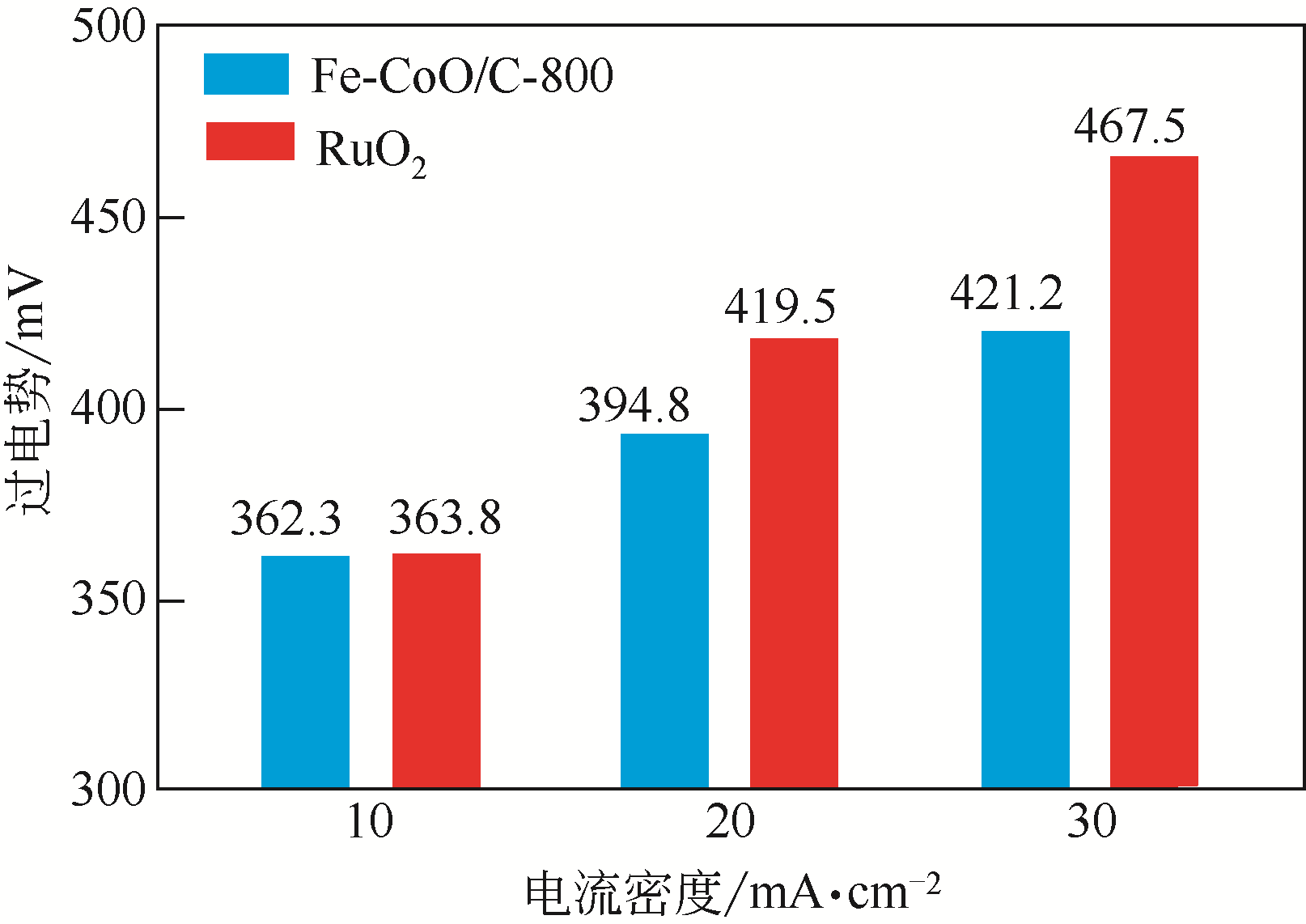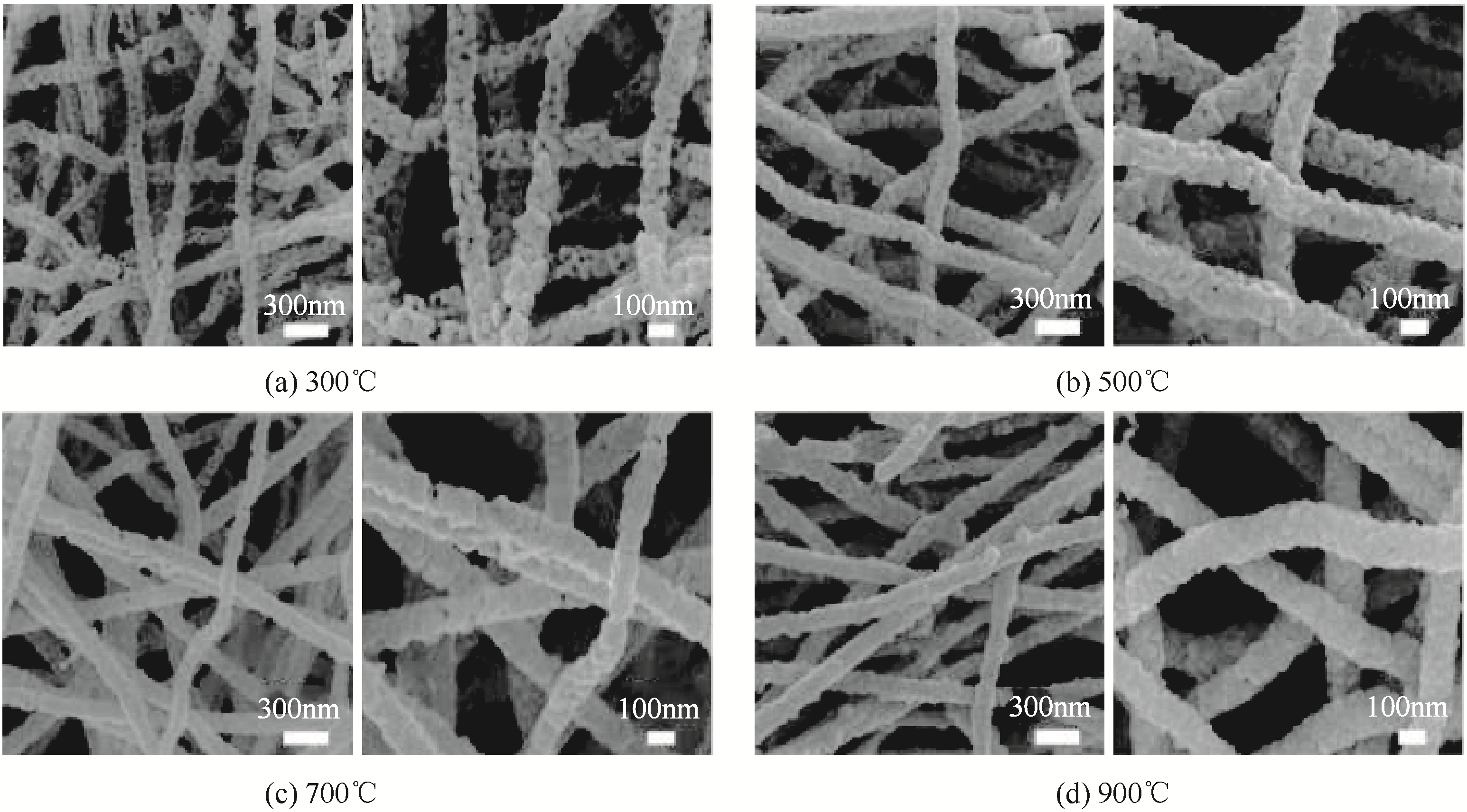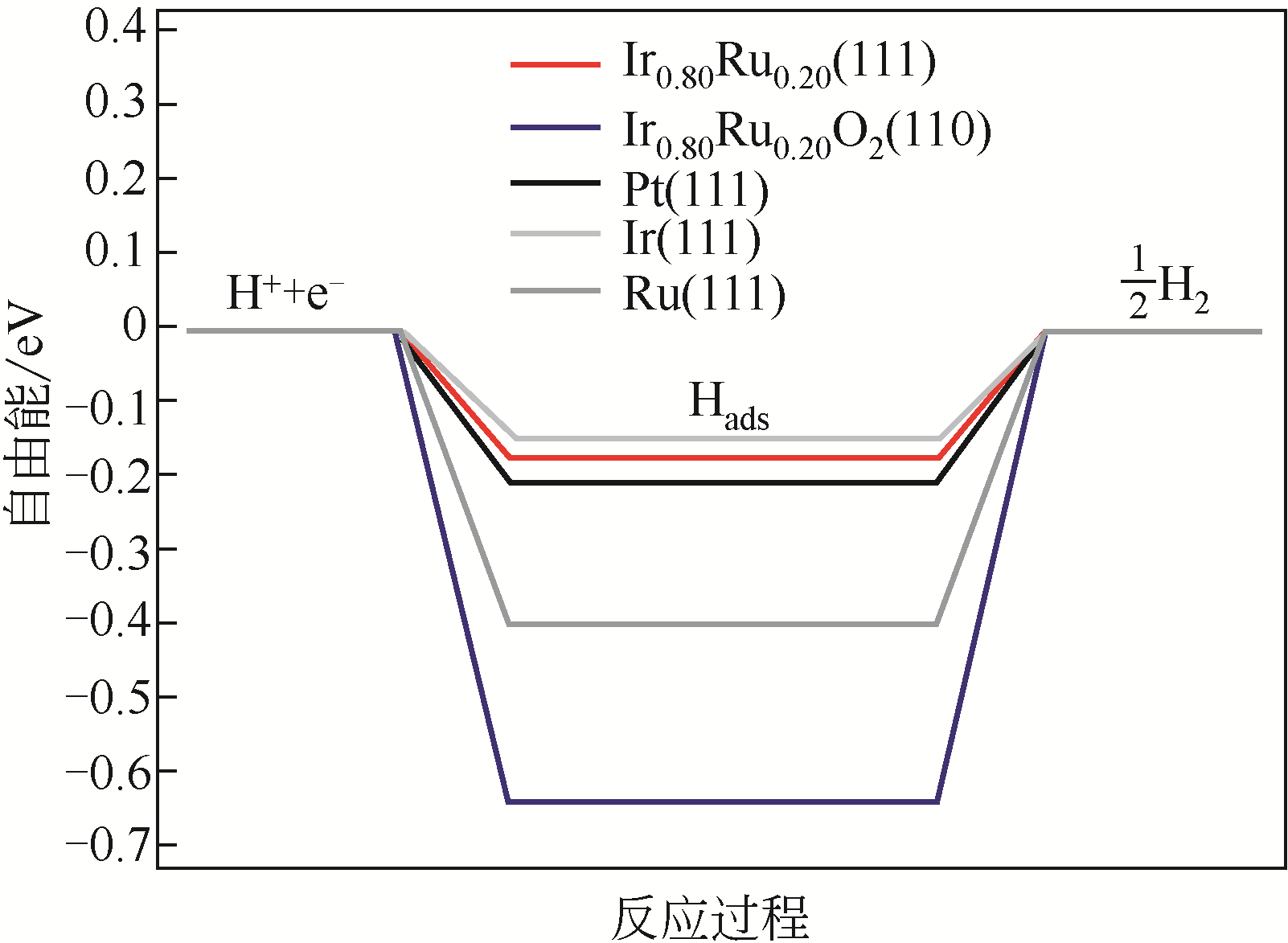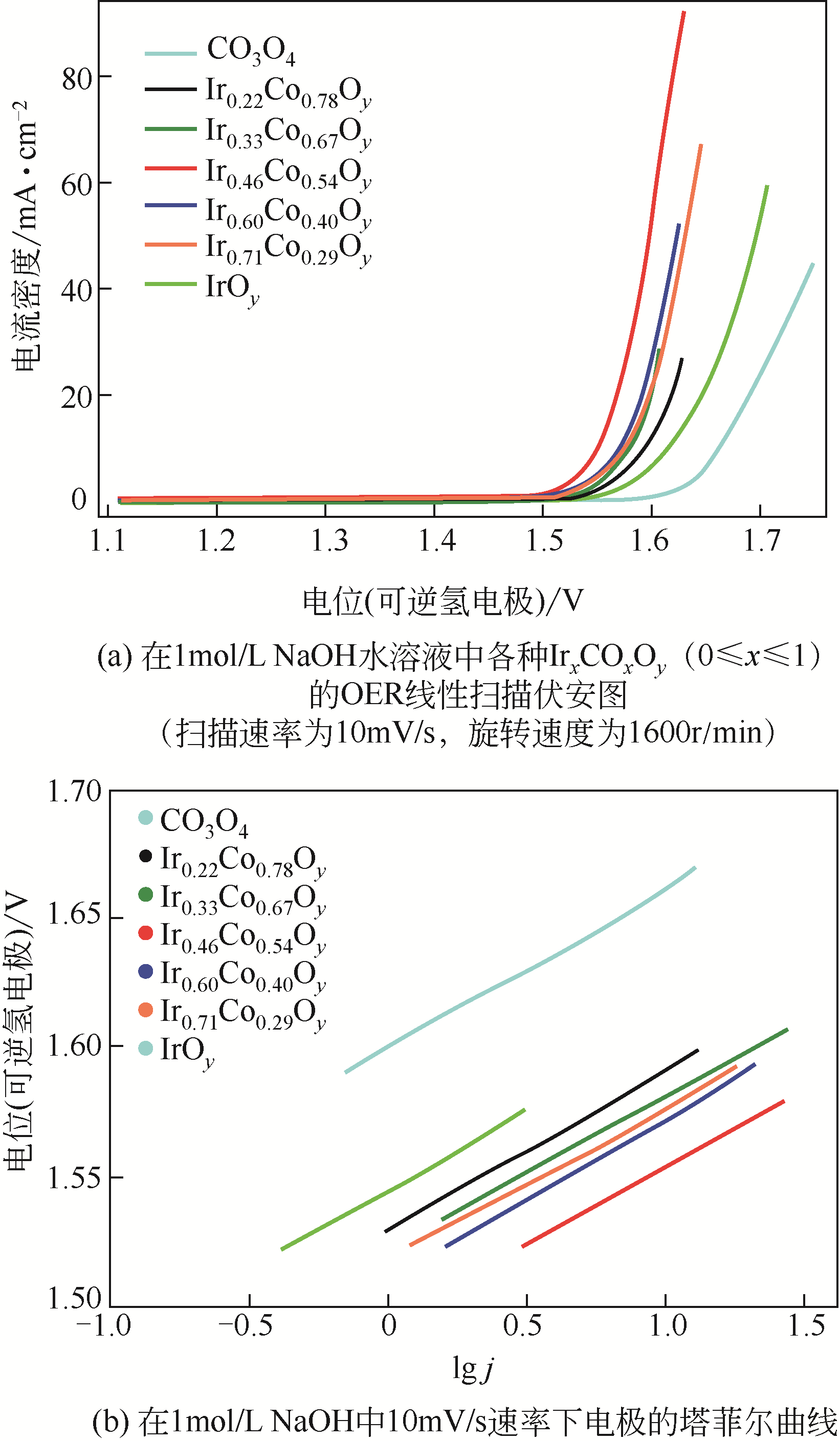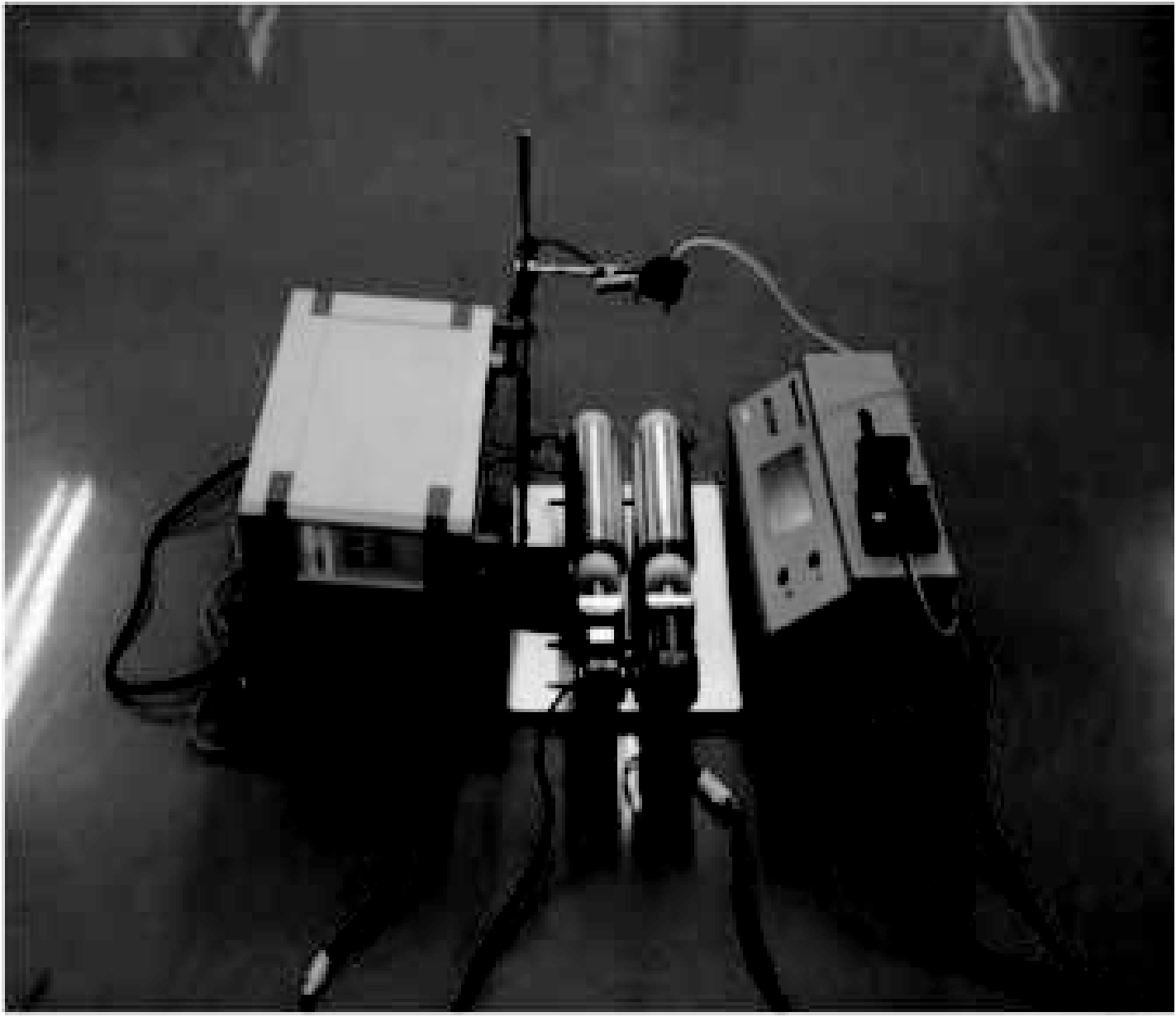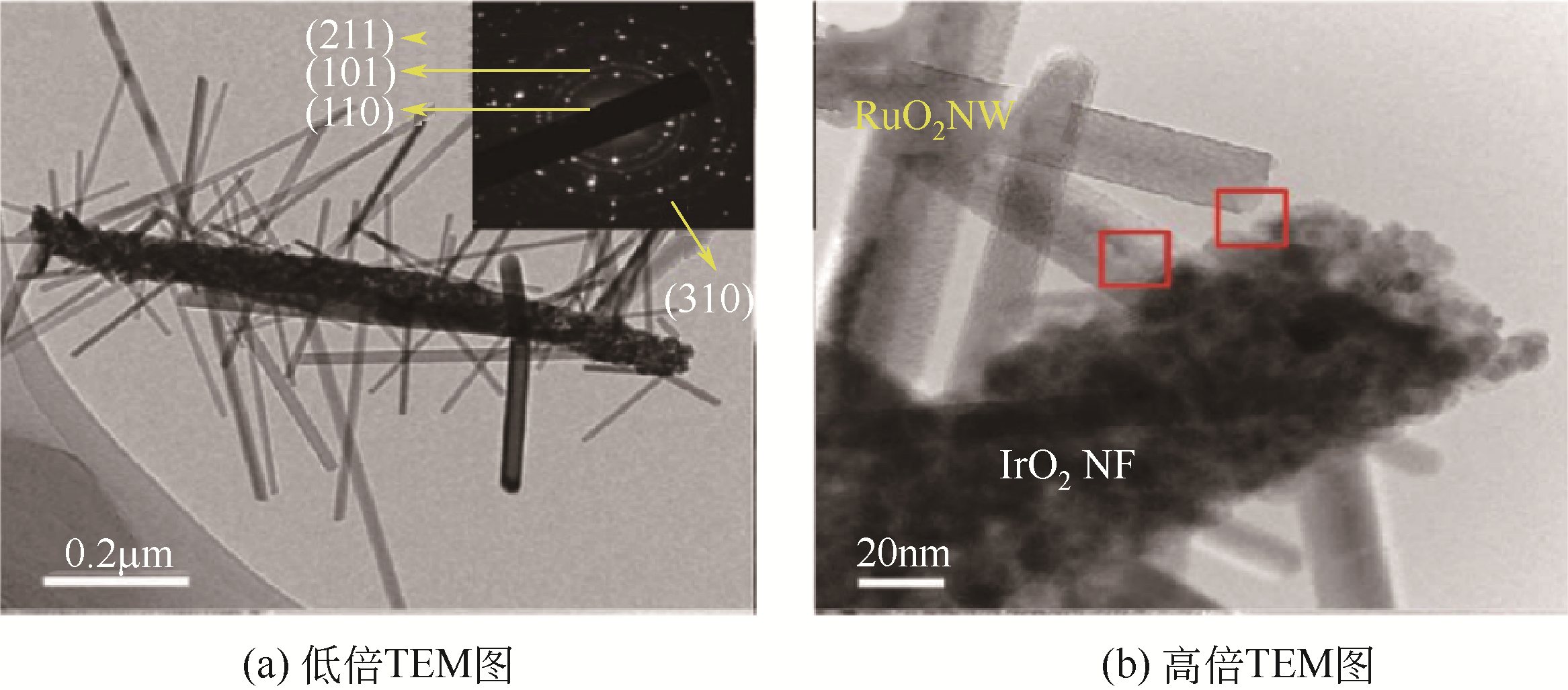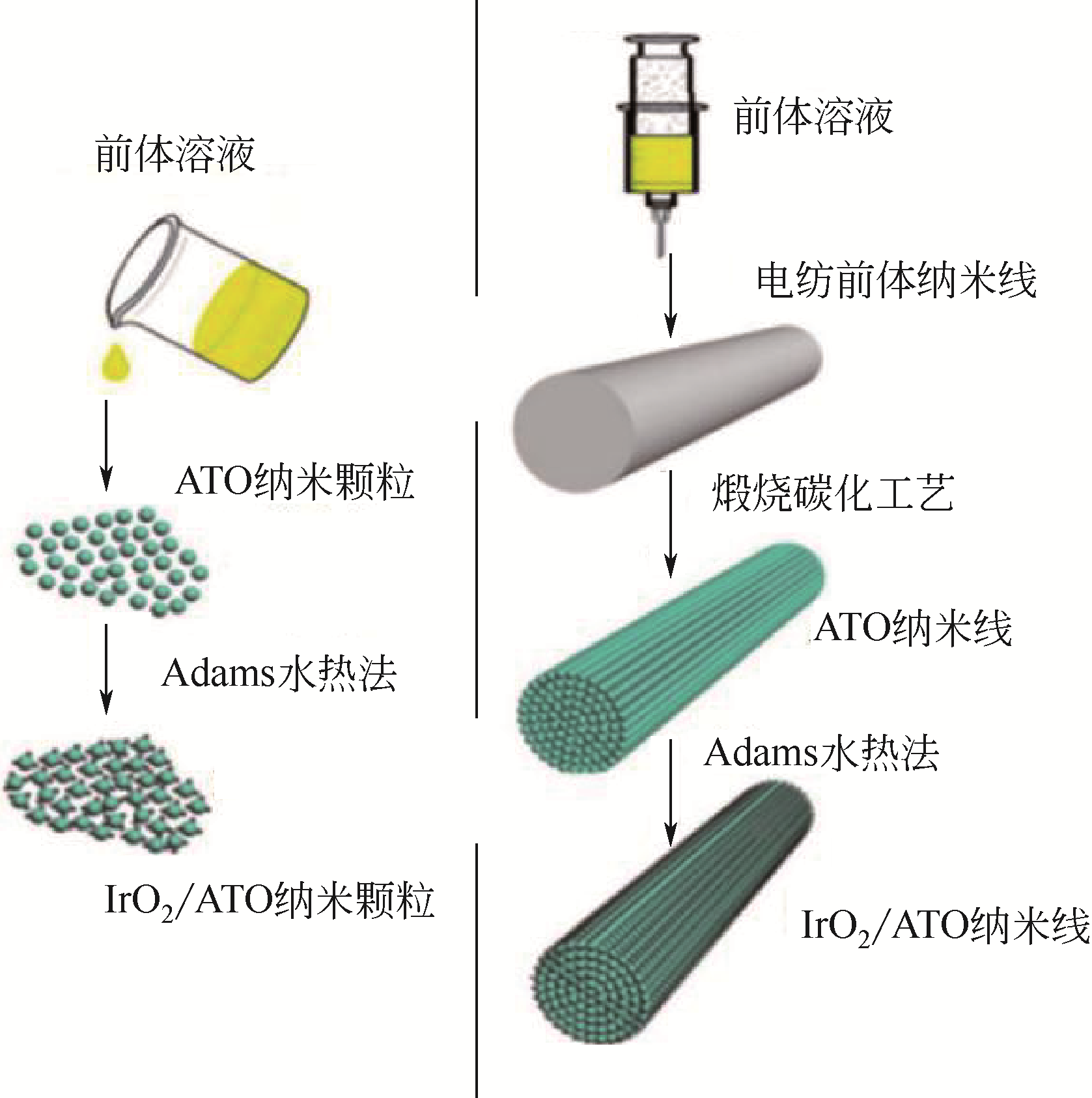化工进展 ›› 2021, Vol. 40 ›› Issue (3): 1395-1412.DOI: 10.16085/j.issn.1000-6613.2020-0630
应用静电纺丝技术的电催化剂及载体材料制备研究进展
- 华南理工大学化学与化工学院,广东 广州 510006
-
收稿日期:2020-04-21出版日期:2021-03-05发布日期:2021-03-17 -
通讯作者:綦戎辉 -
作者简介:崔卓安(1996—),男,硕士研究生,研究方向为催化剂制备及性能。E-mail:461489371@qq.com 。 -
基金资助:国家自然科学基金(51876067);广东省自然科学基金(2018B030306014);广东省高层次人才项目
Research progress in the application of electrospinning technology in the preparation of electrocatalysts and the carrier materials
- School of Chemistry and Chemical Engineering, South China University of Technology, Guangzhou 510006, Guangdong, China
-
Received:2020-04-21Online:2021-03-05Published:2021-03-17 -
Contact:QI Ronghui
摘要:
与机械拉伸等传统的纤维制备方法相比,静电纺丝技术具有操作便利、成本低、生产效率高等优点,是一种更简单、经济的纤维成型技术,被广泛应用于燃料电池、金属-空气电池、水电解装置等领域的电催化过程中。本文首先介绍了静电纺丝的工作原理、工艺影响因素及电纺技术的发展现状;之后主要介绍了静电纺丝在制备催化剂及催化载体材料上的研究进展,包括:①在碱性的电化学反应中,通过静电纺丝制备的过渡金属氧化物及金属-碳复合纤维显示出优异的电催化性能和可观的经济效益;②在水分解反应中,电纺Ir基催化剂具有均匀的一维纳米结构、极高的比表面积和良好的分散性,表现出了优异的催化活性;③在酸性的氧还原和析氧反应中,电纺氧化锡锑(ATO)载体具有优异的导电性,不仅可为催化剂提供良好的电子转移结构及催化活性位点,还能起到一定的结构保护作用,提高了催化活性和稳定性。本文总结了以静电纺丝方法制备催化剂或催化载体材料的优缺点,并发现电纺一维纳米催化剂具有出色的纤维形貌、理想的比表面积及较低的传质阻力,可有效弥补传统金属催化剂颗粒易团聚、活性低等缺点。最后,为进一步提高电纺催化剂的析氧催化性能以及实现电纺纤维排列结构的可控性,对静电纺丝技术的发展提出了几点建议和展望。
中图分类号:
引用本文
崔卓安, 綦戎辉. 应用静电纺丝技术的电催化剂及载体材料制备研究进展[J]. 化工进展, 2021, 40(3): 1395-1412.
CUI Zhuoan, QI Ronghui. Research progress in the application of electrospinning technology in the preparation of electrocatalysts and the carrier materials[J]. Chemical Industry and Engineering Progress, 2021, 40(3): 1395-1412.
| 1 | NADAGOUDA M N, VARMA R S. A greener synthesis of core (Fe, Cu)-shell (Au, Pt, Pd, and Ag) nanocrystals using aqueous vitamin C[J]. Crystal Growth & Design, 2007, 7(12): 2582-2587. |
| 2 | ZHANG J, ZHAO Y, HAN S, et al. Self-assembly of surfactant-like peptides and their applications[J]. Science China: Chemistry, 2014, 57(12): 1634-1645. |
| 3 | SUPOTHINA S, RATTANAKAM R, TAWKAEW S. Hydrothermal synthesis and photocatalytic activity of anatase TiO2 nanofiber[J]. Journal of Nanoscience and Nanotechnology, 2012, 12(6): 4998-5003. |
| 4 | LI N C, MARTIN C R. A high-rate, high-capacity, nanostructured Sn-based anode prepared using sol-gel template synthesis[J]. Journal of the Electrochemical Society, 2001, 148(2): A164-A170. |
| 5 | FAN Z J, YAN J, WEI T, et al. Nanographeneconstructed carbon nanofibers grown on graphene sheets by chemical vapor deposition: high-performance anode materials for lithium ion batteries[J]. ACS Nano, 2011, 5(4): 2787-2794. |
| 6 | INAGAKI M, YANG Y, KANG F. Carbon nanofibers prepared via electrospinning[J]. Advanced Materials, 2012, 24(19): 2547-2566. |
| 7 | KALLURI S, SENG K H, GUO Z, et al. Electrospun lithium metal oxide cathode materials for lithium-ion batteries[J]. RSC Advances, 2013, 3(48): 25576-25601. |
| 8 | TAYLOR G. Electrically driven jets[J]. Proceedings of the Royal Society of London, A: Mathematical and Physical Sciences, 1969, 313(1515): 453-475. |
| 9 | SILL T J, RECUM H A VON. Electro spinning: applications in drug delivery and tissue engineering[J]. Biomaterials, 2008,29(13): 1989-2006. |
| 10 | 漆东岳, 刘延波. 规模化取向静电纺丝技术的现状与展望[J]. 天津工业大学学报, 2012, 31(4): 22-27. |
| QI Dongyue, LIU Yanbo. Status and outlook for large-scale oriented electrospinning technology[J]. Journal of Tianjin Polytechnic University, 2012, 31(4): 22-27. | |
| 11 | RENEKER D H, YARIN A L, FONG H, et al. Bending in stability of electrically charged liquid jets of polymer solutions in electrospinning[J]. Journal of Applied Physics, 2000, 87(9): 4531-4547. |
| 12 | 王中伟. 电纺纳米碳纤维及其电催化性能的研究[D]. 徐州: 江苏师范大学, 2017. |
| WANG Zhongwei. Studies on electrospun carbon nanofibers and its electrocatalytic porperties[D]. Xuzhou: Jiangsu Normal University, 2017. | |
| 13 | LARRONDO L, JOHN MANLEY R ST. Electrostatic fiber spinning from polymer melts. I. Experimental observations on fiber formation and properties[J]. Journal of Polymer Science: Polymer Physics Edition, 1981, 19(6): 909-920. |
| 14 | HAGHI A K, AKBARI M. Trends in electrospinning of natural nanofibers[J]. Physica Status Solidi A, 2007, 204(6): 1830-1834. |
| 15 | KI C S, BAEK D H, GANG K D, et al. Characterization of gelatin nanofiber prepared from gelatin-formic acid solution[J]. Polymer, 2005, 46(14): 5094-5102. |
| 16 | ZHANG C X, YUAN X Y, WU L L, et al. Study on morphology of electrospun poly(vinyl alcohol) mats[J]. European Polymer Journal, 2005, 41(3): 423-432. |
| 17 | MIT-UPPATHAM C, NITHITANAKUL M, SUPAPHOL P. Ultratine electrospun polyamide-6 fibers: effect of solution conditions on morphology and average fiber diameter[J]. Macromolecular Chemistry and Physics, 2004, 205(17): 2327-2338. |
| 18 | CASPER C L, STEPHENS J S, TASSI N G, et al. Controlling surface morphology of electrospun polystyrene fibers: effect of humidity and molecular weight in the electrospinning process[J]. Macromolecules, 2004, 37(2): 573-578. |
| 19 | 李霖, 张旭, 曲飏, 等. 静电纺丝技术与装置的研究进展[J]. 材料导报, 2019, 33(S1): 89-93. |
| LI Lin, ZHANG Xu, QU Yang, et al. Research progress of electrospinning technology and device[J] Materials Reports, 2019, 33(S1): 89-93. | |
| 20 | KIM G, CHO Y S, KIM W D. Stability analysis for multi jets electrospinning process modified with a cylindrical electrode[J]. European Polymer Journal, 2006, 42(9): 2031-2038. |
| 21 | THERON S A, YARIN A L, ZUSSMAN E, et al. Multiple jets in electrospinning: experiment and modeling[J]. Polymer, 2005, 46(9): 2889-2899. |
| 22 | NIU H, LIN T, WANG X. Needleless electrospinning. I. A comparison of cylinder and disk nozzles[J]. Journal of Applied Polymer Science, 2009, 114(6): 3524-3530. |
| 23 | 陈康, 焦晓宁, 柯鹏. 静电纺丝制备取向纤维的技术进展及应用现状[J]. 合成纤维工业, 2015, 38(6): 62-66. |
| CHEN Kang, JIAO Xiaoning, KE Peng. Technological development and application status of oriented fiber by electrospinning[J]. China Synthetic Fiber Industry, 2015, 38(6): 62-66. | |
| 24 | HE X X, ZHENG J, YU G F, et al. Near-field electrospinning: progress and applications[J]. Journal of Physical Chemistry C, 2017, 121(16): 8663-8678. |
| 25 | 段嗣斌, 王荣明. 贵金属-过渡金属化合物复合纳米材料的界面调控及原子尺度原位表征[J]. 稀有金属, 2019, 43(11): 1179-1186. |
| DUAN Sibin, WANG Rongming. Nanomaterials composed of noble metals and transition metal compounds: interface structure control and in-situ characterization at atomic scale[J]. Chinese Journal of Rare Metals, 2019, 43(11): 1179-1186. | |
| 26 | LI M, XIONG Y, LIU X, et al. Facile synthesis of electrospun MFe2O4(M=Co, Ni, Cu, Mn) spinel nanofibers with excellent electrocatalytic properties for oxygen evolution and hydrogen peroxide reduction[J]. Nanoscale, 2015, 7(19): 8920-8930. |
| 27 | YOON K R, LEE G Y, JUNG J W, et al. One-dimensional RuO2/Mn2O3 hollow architectures as efficient bifunctional catalysts for lithium-oxygen batteries[J]. Nano Letters, 2016, 16(3): 2076-2083. |
| 28 | ZHAN Z, LIANG X, LI J, et al. Interfacial engineering of NiO/NiCo2O4 porous nanofibers as efficient bifunctional catalysts for rechargeable zinc-air batteries[J]. ACS Applied Materials & Interfaces, 2020, 12(19): 21661-21669. |
| 29 | 张宝山. 金属氧化物纳米纤维的制备、修饰及催化性质研究[D]. 合肥: 安徽理工大学, 2018. |
| ZHANG Baoshan. Preparation, modification and catalytic properties of metal oxide nanofibers[D]. Hefei: Anhui University of Science and Technology, 2018. | |
| 30 | XU X, WANG W, ZHOU W, et al. Recent advances in novel nanostructuring methods of perovskite electrocatalysts for energy-related applications[J]. Small Methods, 2018, 2(7): 1800071. |
| 31 | WANG Z, TAN S, XIONG Y, et al. Effect of B sites on the catalytic activities for perovskite oxides La0.6Sr0.4CoxFe1-xO3-δ as metal-air batteries catalysts[J]. Progress in Natural Science: Materials International, 2018, 28(4): 399-407. |
| 32 | ZHU Y, ZHOU W, ZHONG Y, et al. A perovskite nanorod as bifunctional electrocatalyst for overall water splitting[J]. Advanced Energy Materials, 2017, 7(8): 1602122. |
| 33 | ZHANG W, WANG H, GUAN K, et al. La0.6Sr0.4Co0.2Fe0.8O3-δ/CeO2 heterostructured composite nanofibers as a highly active and robust cathode catalyst for solid oxide fuel cells[J]. ACS Applied Materials & Interfaces, 2019, 11(30): 26830-26841. |
| 34 | LI A, OOKA H, BONNET N, et al. Stable potential windows for long-term electrocatalysis by manganese oxides under acidic conditions [J]. Angewandte Chemie: International Edition, 2019, 58(15): 5054-5058. |
| 35 | MONDSCHEIN J S, KUMAR K, HOLDER C F, et al. Intermetallic Ni2Ta electrocatalyst for the oxygen evolution reaction in highly acidic electrolytes[J]. Inorganic Chemistry, 2018, 57(10): 6010-6015. |
| 36 | GUO D, WANG J, ZHANG L, et al. Strategic atomic layer deposition and electrospinning of cobalt sulfide/nitride composite as efficient bifunctional electrocatalysts for overall water splitting[J]. Small, 2020, 16(35): 2002432. |
| 37 | CHEN J, WANG J, CHEN J, et al. A bifunctional electrocatalyst of PtNi nanoparticles immobilized on three-dimensional carbon nanofiber mats for efficient and stable water splitting in both acid and basic media[J]. Journal of Materials Science, 2017, 52(22): 13064-13077. |
| 38 | QIU Y, YU J, SHI T, et al. Nitrogen-doped ultrathin carbon nanofibers derived from electrospinning: large-scale production, unique structure, and application as electrocatalysts for oxygen reduction[J]. Journal of Power Sources, 2011, 196(23): 9862-9867. |
| 39 | ZHANG Z, LI X, WANG C, et al. Polyacrylonitrile and carbon nanofibers with controllable nanoporous structures by electrospinning[J]. Macromolecular Materials & Engineering, 2010, 294(10): 673-678. |
| 40 | STRECKOVA M, ORINAKOVA R, MUDRA E, et al. Design of electroactive carbon fibers decorated with metal and metal-phosphide nanoparticles for hydrogen evolution technology[J]. Energy Technology, 2018, 6(7): 1310-1331. |
| 41 | QIU L, HAN X, LU Q, et al. Co3O4 nanoparticles supported on N-doped electrospinning carbon nanofibers as an efficient and bifunctional oxygen electrocatalyst for rechargeable Zn-air batteries[J]. Inorganic Chemistry Frontiers, 2019, 6(12): 3554-3561. |
| 42 | LI W, LI M, WANG C, et al. Fe doped CoO/C nanofibers towards efficient oxygen evolution reaction[J]. Applied Surface Science, 2020, 506: 144680. |
| 43 | LIU K, KATTEL S, MAO V, et al. Electrochemical and computational study of oxygen reduction reaction on nonprecious transition metal/nitrogen doped carbon nanofibers in acid medium[J]. Journal of Physical Chemistry C, 2016, 120(3): 1586-1596. |
| 44 | LI T, LI S, LIU Q, et al. Immobilization of Ni3Co nanoparticles into N-doped carbon nanotube/nanofiber integrated hierarchically branched architectures toward efficient overall water splitting[J]. Advanced Science, 2020, 7(1): 1902371. |
| 45 | LI M, WANG H, ZHU W, et al. RuNi nanoparticles embedded in N-doped carbon nanofibers as a robust bifunctional catalyst for efficient overall water splitting[J]. Advanced Science, 2020, 7(2): 1901833. |
| 46 | WOO S, LEE J, LEE D S, et al. Electrospun carbon nanofibers with embedded Co-ceria nanoparticles for efficient hydrogen evolution and overall water splitting[J]. Materials, 2020, 13(4): 856. |
| 47 | VERMA S, SINHA-RAY S, SINHA-RAY S. Electrospun CNF supported ceramics as electrochemical catalysts for water splitting and fuel cell: a review[J]. Polymers, 2020, 12(1): 238. |
| 48 | RAFIQUE J, YU J, ZHA X, et al. Fabrication of ultra thin and aligned carbon nanofibres from electrospun polyacrylonitrile nanofibres[J]. Bulletin of Materials Science, 2010, 33(5): 553-559. |
| 49 | ZHAO Y, ZHANG J, GUO X, et al. Fe3C@nitrogen doped CNT arrays aligned on nitrogen functionalized carbon nanofibers as highly efficient catalysts for the oxygen evolution reaction[J]. Journal of Materials Chemistry A, 2017, 5(37): 19672-19679. |
| 50 | MOOSTE M, KIBENA-POLDSEPP E, VASSILJEVA V, et al. Electrocatalysts for oxygen reduction reaction based on electrospun polyacrylonitrile, styrene-acrylonitrile copolymer and carbon nanotube composite fibres[J]. Journal of Materials Science, 2019, 54(17): 11618-11634. |
| 51 | WEI K, KIM K O, SONG K H, et al. Nitrogen- and oxygen-containing porous ultrafine carbon nanofiber: a highly flexible electrode material for supercapacitor[J]. Journal of Materials Science & Technology, 2017, 33(5): 424-431. |
| 52 | 兰飞飞. SPE电解水阳极Ir基催化剂的研究[D]. 太原: 中北大学, 2019. |
| LAN Feifei. A study on Ir-based catalysts for SPE electrolyzed water anodes[D]. Taiyuan: North University of China, 2019. | |
| 53 | RASTEN E, HAGEN G, TUNOLD R. Electrocatalysis in water electrolysis with solid polymer electrolyte[J]. Electrochimica Acta, 2003, 48(25/26): 3945-3952. |
| 54 | ABBOTT D F, LEBEDEV D, WALTAR K, et al. Iridium oxide for the oxygen evolution reaction: correlation between particle size, morphology, and the surface hydroxo layer from operando XAS[J]. Chemistry of Materials, 2016, 28(18): 6591-6604. |
| 55 | MAYOUSSE E, MAILLARD F, FOUDA-ONANA F, et al. Synthesis and characterization of electrocatalysts for the oxygen evolution in PEM water electrolysis[J]. International Journal of Hydrogen Energy, 2011, 36(17): 10474-10481. |
| 56 | SONG S, ZHANG H, MA X, et al. Electrochemical investigation of electrocatalysts for the oxygen evolution reaction in PEM water electrolyzers[J]. International Journal of Hydrogen Energy, 2008, 33(19): 4955-4961. |
| 57 | CRUZ J C, BAGLIO V, SIRACUSANO S, et al. Nanosized IrO2 electrocatalysts for oxygen evolution reaction in an SPE electrolyzer[J]. Journal of Nanoparticle Research, 2011, 13(4): 1639-1646. |
| 58 | SAPOUNTZI F M, DIVANE S C, PAPAIOANNOU E I, et al. The role of Nafion content in sputtered IrO2 based anodes for low temperature PEM water electrolysis[J]. Journal of Electroanalytical Chemistry, 2011, 662(1): 116-122. |
| 59 | LEE B S, AHN S H, PARK H Y, et al. Development of electrodeposited IrO2 electrodes as anodes in polymer electrolyte membrane water electrolysis[J]. Applied Catalysis B: Environmental, 2015, 179: 285-291. |
| 60 | KIM S J, JUNG H, LEE C, et al. Comparative study on hydrogen evolution reaction activity of electrospun nanofibers with diverse metallic Ir and IrO2 composition ratios[J]. ACS Sustainable Chemistry & Engineering, 2019, 7(9): 8613-8620. |
| 61 | CHO Y B, YU A, LEE C, et al. Fundamental study of facile and stable hydrogen evolution reaction at electrospun Ir and Ru mixed oxide nanofibers[J]. ACS Applied Materials & Interfaces, 2018, 10(1): 541-549. |
| 62 | FAN L, LI Q, WANG D, et al. Electrospun Ru-RuO2/MoO3 carbon nanorods with multi-active components: a Pt-like catalyst for the hydrogen evolution reaction[J]. Chemical Communications, 2020, 56(5): 739-742. |
| 63 | MOON S, CHO Y B, YU A, et al. Single-step electrospun Ir/IrO2 nanofibrous structures decorated with Au nanoparticles for highly catalytic oxygen evolution reaction[J]. ACS Applied Materials & Interfaces, 2019, 11(2): 1979-1987. |
| 64 | YU A, LEE C, KIM M H, et al. Nanotubular iridium-cobalt mixed oxide crystalline architectures inherited from cobalt oxide for highly efficient oxygen evolution reaction catalysis[J]. ACS Applied Materials & Interfaces, 2017, 9(40):35057-35066. |
| 65 | 朱彩红, 石培峰, 吕张飞, 等. 静电纺丝纳米纤维的制备研究[J]. 无线互联科技, 2018, 15(5): 102-103. |
| ZHU Caihong, SHI Peifeng, Zhangfei LYU, et al. Study on the preparation of electrospinning nanofibers[J]. Wireless Internet Technology, 2018, 15(5): 102-103. | |
| 66 | SULTANOV F, DAULBAYEV C, BAKBOLAT B, et al. Aligned composite SrTiO3/PAN fibers as 1D photocatalyst obtained by electrospinning method[J]. Chemical Physics Letters, 2019, 737: 136821. |
| 67 | LEE J, YANG H S, LEE N S, et al. Hierarchically assembled 1-dimensional hetero-nanostructures: single crystalline RuO2 nanowires on electrospun IrO2 nanofibres[J]. Crystengcomm, 2013, 15(13): 2367-2371. |
| 68 | 刘翔. 静电纺丝法制备锑掺杂氧化锡纳米材料的研究[D]. 哈尔滨: 哈尔滨工业大学, 2014. |
| LIU Xiang. Study on preparation of antimony doped tin oxide nanomaterials by electrospinning[D]. Harbin: Harbin Institute of Technology, 2014. | |
| 69 | KIM Y S, KIM W B, JOO Y L. Further improvement of battery performance via charge transfer enhanced by solution-based antimony doping into tin dioxide nanofibers[J]. Journal of Materials Chemistry A, 2014, 2(22): 8323-8327. |
| 70 | ZHAO N, DENG L, LUO D, et al. Electrospun sntimony tin oxide nanofibers with superior stability as anode material for Li-ion batteries[J]. International Journal of Electrochemical Science, 2018, 13(11): 10612-10625. |
| 71 | 胡沛然, 王宏志, 李耀刚, 等. 静电纺制备ATO聚集状态可控的柔性导电材料及其性能研究[J]. 硅酸盐通报, 2012, 31(4): 813-817, 821. |
| HU Peiran, WANG Hongzhi, LI Yaogang, et al. Synthesis and properties of flexible conductive materials with a controllable state of ATO aggregation via electrospinning[J]. Bulletin of the Chinese Ceramic Society, 2012, 31(4): 813-817, 821. | |
| 72 | CAVALIERE S, JIMENEZ-MORALES I, ERCOLANO G, et al. Highly stable PEMFC electrodes based on electrospun antimony-doped SnO2[J]. ChemElectroChem, 2015, 2(12): 1966-1973. |
| 73 | LIU G, BONAKDARPOUR A, WANG X, et al. Antimony-doped tin oxide nanofibers as catalyst support structures for the methanol oxidation reaction in direct methanol fuel cells[J]. Electrocatalysis, 2019, 10(3): 262-271. |
| 74 | KIM J C, OH S I, KANG W, et al. Superior anodic oxidation in tailored Sb-doped SnO2/Ru-2 composite nanofibers for electrochemical water treatment[J]. Journal of Catalysis, 2019, 374:118-126. |
| 75 | LIU G, XU J, WANG Y, et al. An oxygen evolution catalyst on an antimony doped tin oxide nanowire structured support for proton exchange membrane liquid water electrolysis[J]. Journal of Materials Chemistry A, 2015, 3(41): 20791-20800. |
| 76 | REN Y, WANG S, LIU R, et al. A novel route towards well-dispersed short nanofibers and nanoparticles via electrospinning[J]. RSC Advances, 2016, 6(36): 30139-30147. |
| 77 | MUDRA E, SHEPA I, MILKOVIC O, et al. Effect of iron doping on the properties of SnO2 nano/microfibers[J]. Applied Surface Science, 2019, 480:876-881. |
| 78 | AN G H, LEE D Y, LEE Y J, et al. Ultrafast lithium storage using antimony-doped tin oxide nanoparticles sandwiched between carbon nanofibers and a carbon skin[J]. ACS Applied Materials & Interfaces, 2016, 8(44): 30264-30270. |
| 79 | LIU Q, ZHANG L, CHEN J F, et al. Synthesis of TiO2@ATO core-shell nanofibers using coaxial electrospinning[J]. Materials Letters, 2014, 137: 339-342. |
| [1] | 张明焱, 刘燕, 张雪婷, 刘亚科, 李从举, 张秀玲. 非贵金属双功能催化剂在锌空气电池研究进展[J]. 化工进展, 2023, 42(S1): 276-286. |
| [2] | 时永兴, 林刚, 孙晓航, 蒋韦庚, 乔大伟, 颜彬航. 二氧化碳加氢制甲醇过程中铜基催化剂活性位点研究进展[J]. 化工进展, 2023, 42(S1): 287-298. |
| [3] | 谢璐垚, 陈崧哲, 王来军, 张平. 用于SO2去极化电解制氢的铂基催化剂[J]. 化工进展, 2023, 42(S1): 299-309. |
| [4] | 杨霞珍, 彭伊凡, 刘化章, 霍超. 熔铁催化剂活性相的调控及其费托反应性能[J]. 化工进展, 2023, 42(S1): 310-318. |
| [5] | 胡喜, 王明珊, 李恩智, 黄思鸣, 陈俊臣, 郭秉淑, 于博, 马志远, 李星. 二硫化钨复合材料制备与储钠性能研究进展[J]. 化工进展, 2023, 42(S1): 344-355. |
| [6] | 张杰, 白忠波, 冯宝鑫, 彭肖林, 任伟伟, 张菁丽, 刘二勇. PEG及其复合添加剂对电解铜箔后处理的影响[J]. 化工进展, 2023, 42(S1): 374-381. |
| [7] | 许春树, 姚庆达, 梁永贤, 周华龙. 共价有机框架材料功能化策略及其对Hg(Ⅱ)和Cr(Ⅵ)的吸附性能研究进展[J]. 化工进展, 2023, 42(S1): 461-478. |
| [8] | 王乐乐, 杨万荣, 姚燕, 刘涛, 何川, 刘逍, 苏胜, 孔凡海, 朱仓海, 向军. SCR脱硝催化剂掺废特性及性能影响[J]. 化工进展, 2023, 42(S1): 489-497. |
| [9] | 邓丽萍, 时好雨, 刘霄龙, 陈瑶姬, 严晶颖. 非贵金属改性钒钛基催化剂NH3-SCR脱硝协同控制VOCs[J]. 化工进展, 2023, 42(S1): 542-548. |
| [10] | 程涛, 崔瑞利, 宋俊男, 张天琪, 张耘赫, 梁世杰, 朴实. 渣油加氢装置杂质沉积规律与压降升高机理分析[J]. 化工进展, 2023, 42(9): 4616-4627. |
| [11] | 王鹏, 史会兵, 赵德明, 冯保林, 陈倩, 杨妲. 过渡金属催化氯代物的羰基化反应研究进展[J]. 化工进展, 2023, 42(9): 4649-4666. |
| [12] | 张启, 赵红, 荣峻峰. 质子交换膜燃料电池中氧还原反应抗毒性电催化剂研究进展[J]. 化工进展, 2023, 42(9): 4677-4691. |
| [13] | 王伟涛, 鲍婷玉, 姜旭禄, 何珍红, 王宽, 杨阳, 刘昭铁. 醛酮树脂基非金属催化剂催化氧气氧化苯制备苯酚[J]. 化工进展, 2023, 42(9): 4706-4715. |
| [14] | 葛亚粉, 孙宇, 肖鹏, 刘琦, 刘波, 孙成蓥, 巩雁军. 分子筛去除VOCs的研究进展[J]. 化工进展, 2023, 42(9): 4716-4730. |
| [15] | 吴海波, 王希仑, 方岩雄, 纪红兵. 3D打印催化材料开发与应用进展[J]. 化工进展, 2023, 42(8): 3956-3964. |
| 阅读次数 | ||||||
|
全文 |
|
|||||
|
摘要 |
|
|||||

